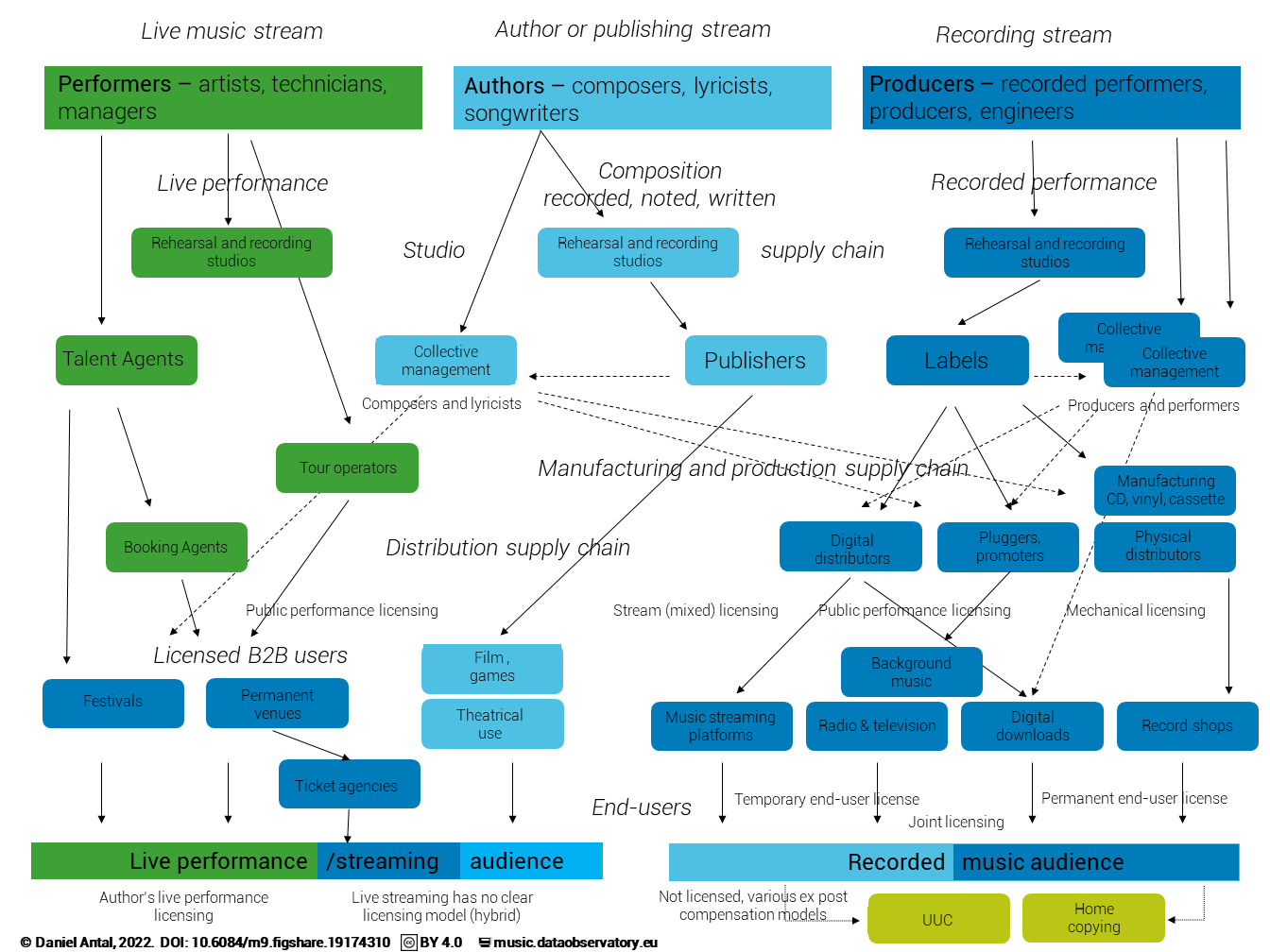The Music Value Chain
A map of the music ecosystem
Our ambition is to build a comprehensive data source and online data analysis tools for the European music industry. This requires a map of the music ecosystem — we need to understand where value is created and money is exchanged, and we need to observe how much is this value and how much is being paid for it.
The value chain is a concept describing the full chain of a businesses' activities in the creation of a product or service – from the initial reception of materials all the way through its delivery to market, and everything in between. Some services, like car manufacturing and banking services, are offered by a large corporation that creates the service alone. The music industry is different. In Europe it comprises of hundreds of thousands of freelancers, microenterprises, and a few small-and medium sized or large enterprises that form a creative network to deliver projects.
Our initial view of the European music value chain is depicted in the chart.

Our value chain model was perfected in various research and development projects that aimed to understand the problems and increase the revenues of the Hungarian, Slovak, Croatian, and UK music industries. We have asked over 8 years more than 4000 music professionals in 12 countries about how they work and how they get paid (See our Central European Music Industry Report.)
It is based on the standard, accepted description of the music industry with the “three revenue stream model” in the United States (Hull et al. 2011) and the European Union (Leurdijk et al. 2012; Leurdijk and Ottilie 2012). It is built upon the actual application of competition law in EU jurisdictions (Antal 2017, 2019), and it is intended for further research and publication.
The value chain is a good tool to localize information sources and plan to collect data in a systematic way. For example, in the case of our music value chain we must focus on some challenges:
Unlike in other industries, most hours of music are listened to without paying consumers (radio, YouTube, ad-supported streams, home copying, torrenting). Understanding the advertising revenue streams is important.
The music industry is both very local and global. Small labels sell all over the world on digital platforms. But they should focus on markets where there is an interest for their music or where the prices are high, where they have a real chance to get playlisted.
We must understand why some languages, or women are disadvantaged in this value chain, and what intervention can help this situation.
The aim of our mapping is to help the industry solve real problems: keep its revenues in line with the growth of uses in more and more electronic gadgets where people use music, compensate home copying, or close the value gap, or find out where women get underpaid or underrepresented. Our value chain helps us designing data collection plans for complex analysis of music uses, prices and revenues that we will introduce in a subsequent blogpost.

References
Antal, Daniel. 2017. “The Competition of Unlicensed, Licensed and Illegal Uses on the Markets of Music and Audiovisual Works [A szabad felhasználások, a jogosított tartalmak és az illegális felhasználások versenye a zenék és audiovizuális alkotások hazai piacán].” Artisjus - not public.
———. 2019. “The Competition of Unlicensed, Licensed and Illegal Uses on the Markets of Music and Audiovisual Works [A szabad felhasználások, a jogosított tartalmak és az illegális felhasználások versenye a zenék és audiovizuális alkotások hazai piacán].” Artisjus - not public.
Competition & Markets Authority. 2022. “Music and Streaming Market Study. Statement of Scope.” Competition & Markets Authority. https://assets.publishing.service.gov.uk/media/61f17285d3bf7f0546a99df2/Music_and_streaming_Statement_of_Scope_final.pdf.
Hull, Geoffrey P., Thomas W. Hutchison, Richard Strasser, and Geoffrey P. Hull. 2011. The Music Business and Recording Industry Delivering Music in the 21st Century. New York: Routledge. http://search.ebscohost.com/login.aspx?direct=true&scope=site&db=nlebk&db=nlabk&AN=345262.
Leurdijk, Adnra, Sivlian de Munck, Tijs van den Broek, Arjana van der Plas, Walter Manshanden, and Elmer Rietveld. 2012. “Statistical, Ecosystems and Competitiveness Analysis of the Media and Content Industries: A Quantiative Overview.” EUR 25277 EN. Edited by Jean Paul Simon. Seville:Spain: Joint Research Centre of the European Commission - Institute for Prospective Technological Studies. http://ftp.jrc.es/EURdoc/JRC69435.pdf.
Leurdijk, Adnra, and Nieuwenhuis Ottilie. 2012. “Statistical, Ecosystems and Competitiveness Analysis of the Media and Content Industries. The Music Industry.” 25277 EN. Edited by Jean Paul Simon. Luxembourg: Publications Office of the European Union, 2012: Joint Research Centre Institute for Prospective Technological Studies (IPTS). http://ftp.jrc.es/EURdoc/JRC69816.pdf.